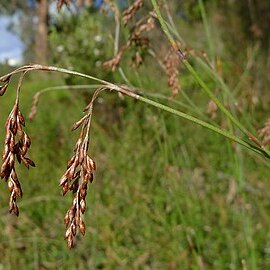Herbs, dioecious, perennial, caespitose or with elongated rhizomes. Rhizomes glabrous or with a dense woolly pubescence, wholly or partially covered by scarious scales; cluster roots often present. Culms unbranched or branched, mostly terete to subterete, mostly striate, apparently glabrous to densely pubescent, often covered with pale, appressed, peltate trichomes (fan hairs) so closely appressed as to appear glabrous. Sheaths appressed, striate, glabrous or ciliate or villous, often covered with pale, appressed, scale-like trichomes; margin scarious or hyaline, distinct or indistinct; lamina linear, erect; both margin and lamina often weathering away. Inflorescence: males and females often very dissimilar; spikelets 1–many-flowered; flowers shortly pedicellate; females often with (1) 2 small unequal floral bracts on the axis between the glume and the flower. Male flowers: tepals 5 or 6, glabrous; stamens usually 3, pistillode small or absent. Female flowers dorsiventrally compressed or not compressed; tepals 6, glabrous or pubescent; outer tepals usually keeled, often with apical wings, sometimes with long appendages; ovary triquetrous, with a single locule and ovule; style 3-branched, the basal part (half or less) connate and mostly persistent on the nut, staminodes small or absent. Fruit a glabrous nut, ovoid or ellipsoid, shed with attached tepals and floral bracts if present. Culm anatomy: chlorenchyma mostly of short peg-cells, interrupted by groups of pillar cells that extend from the parenchyma sheath to the epidermis.
Plants dioec. Male and female infls often dissimilar. Spikelets us. many-fld in both sexes; upper floral bracts imbricate; bractlets 0, or rarely 2 in ♀ (0 in N.Z. sp.). Tepals 6–(4), variously shaped. ♂ with 3–(2) stamens; anthers 1-celled; ovary rud., or 0. ♀ with 3 or 0 staminodia; ovary 1-locular, with a single, pend. ovule; styles 3–(2),free or united to midway. Fr. ind., or occ. dehiscing along one side. Rush-like, perennial herbs. Culms ∞, terete, simple (in N.Z. sp.), from a stout, creeping rhizome. Lvs reduced to persistent sheaths, closely appressed to culms. About 15 spp., mainly endemic to Australia, but 1 in Southeast Asia and 1 in Southern Chile. The N.Z. sp. is endemic.

